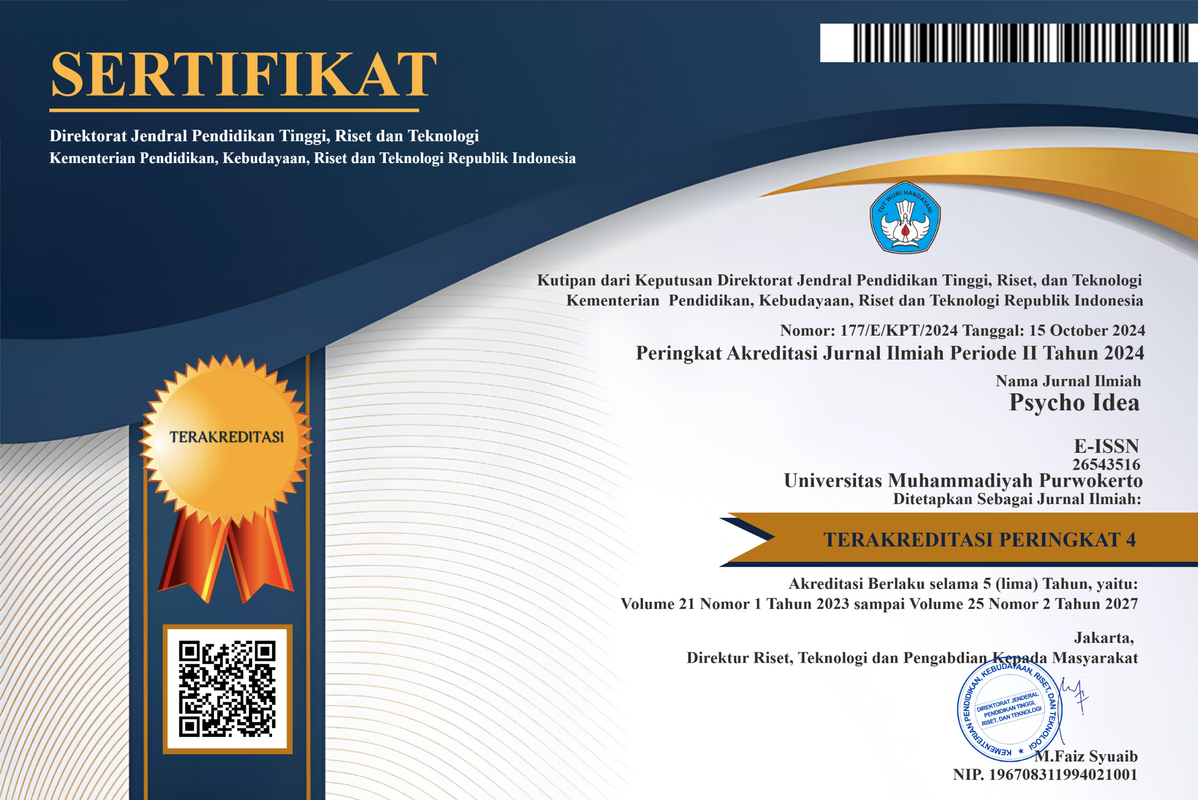DINAMIKA RESILIENSI PADA MAHASISWA DIFABEL UNIVERSITAS GADJAH MADA
DOI:
https://doi.org/10.30595/psychoidea.v16i2.3364Abstract
Belajar merupakan hak semua orang, tidak terkecuali bagi mahasiswa difabel. Meskipun mahasiswa difabel memiliki kekurangan dalam beberapa kemampuan, namun mereka dapat menjadikan kekurangan tersebut menjadi motivasi mereka untuk berkembang dan berprestasi. Kekuranganitu memaksa mereka berusaha dua tiga kali lebih keras daripada mahasiswa biasanya. Untuk itu penelitian ini bertujuan untuk mengekplorasi dinamika resiliensi mahasiswa difabel dalam belajar dan beradaptasi di lingkungan dengan mayoritas orang normal. Banyak hal yang harus dihadapi oleh seperti stigma masyarakat, kurangnya fasilitas pendukung, dan hinaan dari teman sebayanya. Penelitian ini menggunakan metode kualitatif dengan dua responden mahasiswa difabel di Universitas Gadjah Mada. Hasil penelitian ini menunjukkan bahwa faktor lingkungan dan internal dalam diri mahasiswa difabel saling berkontibusi dalam mendukung keberhasilannya belajar dan beradaptasi. Bahkan ketika lingkungannya tidak mendukungnya untuk berkembang, mereka memiliki resiliensi diri yang luar biasa sehingga mampu melewati semua tantangan yang ada di hadapannya. Resiliensi mereka inilah yang membuat mereka dapat menyelesaikan semua rintangan yang ada.
Â
Kata kunci : Resiliensi ; Difabel ; Mahasiswa.
Â
Â
ABSTRACT
Learning is everyone's right, no exception for students with disabilities. Even though students with disabilities have shortcomings in some abilities, they can make these deficiencies become their motivation for developing and achieving. The shortage made them to try two or three times harder than ordinary students. For this reason, this study aims to explore resilience dynamicsof disabled students in learning and adapting in an environment that have majority of normal people. Many things must be dealt with, such as community stigma, lack of supporting facilities, and insults from peers. This study uses a qualitative method with two students with disabilities at Gadjah Mada University. The results of this study indicate that the environmental and internal factors within students with disabilities contribute to each other in supporting their success in learning and adapting. Even when the environment does not support to develop, they have extraordinary self-resilience so that they are able to go through all those challenges. Their resilience makes them able to solve all the obstacles.
Â
Keywords: Resilience ; Disabilities ; College Student
References
Connelly, F. M., & D. J., Clandinin. (1990). Story of Experience and Narrative Inquiry.Educational Researcher, 19(5): 2–14.
Cresswell, J. W., Hanson, W. E., Clark, V. L. P., dan Morales, A. 2007. Qualitative Research Designs: Selection and Implementation. The Counseling Psychologist, 35(2): 236–264.
Firdaus, E. (2010). Pendidikan Inklusif dan Implementasinya di Indonesia. Seminar Nasional Pendidikan. Universitas Jenederal Soedirman, Purwokerto.
Grotberg, E. H. (2003). Gaining Strength from Adversity. USA: Praeger Publisher.
Gusti. (2014). Berprestasi, Mahasiswa Difabel UNIVERSITAS GADJAH MADA Bentuk UKM Peduli Difabel. Diakses dari www.Universitas Gadjah Mada.ac.id/id/berita
Joyce, M. (2015). Using narrative in nursing research. Nursing Standard, 29(38), 36–41.
Lang, H.G. (2002). Higher Education for Deaf Students: Research Priorities in the New Millenium. Journal of Dief Studies and Deaf Education, 7(4).267–280.
Lintangsari, A. Poetri. (2014).Identifikasi Kebutuhan Mahasiswa Tuli Dalam Pembelajaran Bahasa Tulis.Indonesian Journal of Disability Studies, 1(1): 60–70.
Nasution, S., M. (2011). Resiliensi: Daya Pegas Menghadapi Trauma Kehidupan. Medan: USUPress.
Ong, A. D. & Bergeman, C.S.(2004).Resilience and Adaptation to Stress in Later Life: Empirical Perspectives and Conceptual Implications.Ageing International, 29(3): 219–246.
Reivich, K.&Shatte, A. (2002). The Resilience Factor: 7 Keys to Finding Your Inner Strength and Overcoming Life’s Hurdles. USA: Three Rivers Press.
Stinson, M., & Walter, G. (1997). Improving retention for deaf and hard of hearing students: What the research tells us. Journal of American Deafness and Rehabilitation Association, 30, 14–23.
Wilson, R. A. (2007). Combining Historical Research and Narrative Inquiry to Create Chronicles and Narratives. The Qualitative Report, 12(1), 20–39.
Downloads
Published
Issue
Section
License
Authors published in this journal agree to the following terms:
- The copyright of each article is retained by the author (s) without restrictions
- The journal allows the author(s) to retain publishing rights without restrictions
- The author grants the journal the first publication rights with the work simultaneously licensed under the Creative Commons Attribution License, allowing others to share the work with an acknowledgment of authorship and the initial publication in this journal.
- Authors may enter into separate additional contractual agreements for the non-exclusive distribution of published journal versions of the work (for example, posting them to institutional repositories or publishing them in a book), with acknowledgment of their initial publication in this journal
- Authors are permitted and encouraged to post their work online (For example in the Institutional Repository or on their website) before and during the submission process, as this can lead to productive exchanges, as well as earlier and larger citations of published work
- Articles and all related material published are distributed under a Creative Commons Attribution-4.0 International Public License (CC - BY 4.0).
License
Psycho Idea is licensed under a Creative Commons Attribution- 4.0 International Public License (CC - BY 4.0).
You are free to :
Share — copy and redistribute the material in any medium or format
Adapt — remix, transform, and build upon the material for any purpose, even commercially











